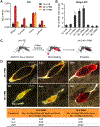E93 confers steroid hormone responsiveness of digestive enzymes to promote blood meal digestion in the midgut of the mosquito Aedes aegypti
- PMID: 33901693
- PMCID: PMC8947147
- DOI: 10.1016/j.ibmb.2021.103580
E93 confers steroid hormone responsiveness of digestive enzymes to promote blood meal digestion in the midgut of the mosquito Aedes aegypti
Abstract
Anautogenous female mosquitoes obtain the nutrients needed for egg development from vertebrate blood, and consequently they transmit numerous pathogens of devastating human diseases. Digestion of blood proteins into amino acids that are used for energy production, egg maturation and replenishment of maternal reserves is an essential part of the female mosquito reproductive cycle. However, the regulatory mechanisms underlying this process remain largely unknown. Here, we report that the transcription factor E93 is a critical factor promoting blood meal digestion in adult females of the major arboviral vector Aedes aegypti in response to the steroid hormone 20-hydroxyecdysone (20E). E93 was upregulated in the female mosquito midgut after a blood meal, and RNA interference (RNAi)-mediated knockdown of E93 inhibited midgut blood digestion. E93 RNAi depletion repressed late trypsin (LT), serine protease I (SPI), SPVI and SPVII, and activated early trypsin (ET) expression in the female mosquito midgut after a blood meal. Injection of 20E activated E93, LT, SPI, SPVI and SPVII, and repressed ET expression, whereas RNAi knockdown of the ecdysone receptor (EcR) repressed E93, LT, SPI, SPVI and SPVII, and activated ET expression in the midgut. Furthermore, E93 depletion resulted in a complete loss of 20E responsiveness of LT, SPVI and SPVII. Our findings reveal important mechanisms regulating blood meal digestion in disease-transmitting mosquitoes.
Keywords: 20-Hydroxyecdysone; Blood meal digestion; E93; Mosquito; Serine protease; Steroid hormone.
Copyright © 2021. Published by Elsevier Ltd.
Figures







Similar articles
-
microRNA miR-275 is indispensable for blood digestion and egg development in the mosquito Aedes aegypti.Proc Natl Acad Sci U S A. 2010 Dec 28;107(52):22391-8. doi: 10.1073/pnas.1016230107. Epub 2010 Nov 29. Proc Natl Acad Sci U S A. 2010. PMID: 21115818 Free PMC article.
-
Hormone-dependent activation and repression of microRNAs by the ecdysone receptor in the dengue vector mosquito Aedes aegypti.Proc Natl Acad Sci U S A. 2021 Jun 29;118(26):e2102417118. doi: 10.1073/pnas.2102417118. Proc Natl Acad Sci U S A. 2021. PMID: 34155112 Free PMC article.
-
Insulin-like peptides and the target of rapamycin pathway coordinately regulate blood digestion and egg maturation in the mosquito Aedes aegypti.PLoS One. 2011;6(5):e20401. doi: 10.1371/journal.pone.0020401. Epub 2011 May 27. PLoS One. 2011. PMID: 21647424 Free PMC article.
-
Ecdysone and the cell cycle: investigations in a mosquito cell line.J Insect Physiol. 2010 Oct;56(10):1396-401. doi: 10.1016/j.jinsphys.2010.03.016. Epub 2010 Mar 28. J Insect Physiol. 2010. PMID: 20303973 Free PMC article. Review.
-
Four-way regulation of mosquito yolk protein precursor genes by juvenile hormone-, ecdysone-, nutrient-, and insulin-like peptide signaling pathways.Front Physiol. 2014 Mar 20;5:103. doi: 10.3389/fphys.2014.00103. eCollection 2014. Front Physiol. 2014. PMID: 24688471 Free PMC article. Review.
Cited by
-
Reciprocal interactions between neuropeptide F and RYamide regulate host attraction in the mosquito Aedes aegypti.Proc Natl Acad Sci U S A. 2024 Jul 9;121(28):e2408072121. doi: 10.1073/pnas.2408072121. Epub 2024 Jul 1. Proc Natl Acad Sci U S A. 2024. PMID: 38950363 Free PMC article.
-
Comprehensive proteolytic profiling of Aedes aegypti mosquito midgut extracts: Unraveling the blood meal protein digestion system.PLoS Negl Trop Dis. 2025 Feb 6;19(2):e0012555. doi: 10.1371/journal.pntd.0012555. eCollection 2025 Feb. PLoS Negl Trop Dis. 2025. PMID: 39913535 Free PMC article.
-
Biochemical and physiological characterization of Aedes aegypti midgut chymotrypsin.Sci Rep. 2025 Mar 20;15(1):9685. doi: 10.1038/s41598-025-93413-7. Sci Rep. 2025. PMID: 40113878 Free PMC article.
-
Transcription factor E93 regulates vitellogenesis via the vitelline membrane protein 26Ab gene in Chilo Suppressalis.Mol Biol Rep. 2024 Dec 7;52(1):41. doi: 10.1007/s11033-024-10127-1. Mol Biol Rep. 2024. PMID: 39644360
-
Single-cell transcriptional landscapes of Aedes aegypti midgut and fat body after a bloodmeal.Cell Genom. 2025 Aug 13;5(8):100924. doi: 10.1016/j.xgen.2025.100924. Epub 2025 Jun 25. Cell Genom. 2025. PMID: 40570845 Free PMC article.
References
-
- Attardo Geoffrey M, Hansen Immo A, and Raikhel Alexander S 2005. Nutritional regulation of vitellogenesis in mosquitoes: implications for anautogeny. Insect Biochem Mol Biol 35:661–675. - PubMed
-
- Baehrecke Eric H, and Thummel Carl S 1995. The Drosophila E93 gene from the 93F early puff displays stage- and tissue-specific regulation by 20-hydroxyecdysone. Dev Biol 171:85–97. - PubMed
-
- Barbosa P, and Peters TM 1969. A comparative study of egg hatching techniques for Aedes aegypti (L.). Mosq News 29:548–551.
-
- Barrett Alan DT, and Higgs Stephen 2007. Yellow fever: a disease that has yet to be conquered. Annu Rev Entomol 52:209–229. - PubMed
Publication types
MeSH terms
Substances
Grants and funding
LinkOut - more resources
Full Text Sources
Other Literature Sources
Medical

